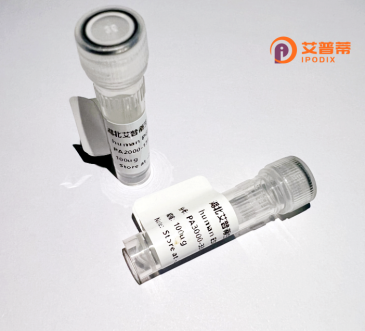
| 纯度 | >90%SDS-PAGE. |
| 种属 | Human |
| 靶点 | TAB1 |
| Uniprot No | Q15750 |
| 内毒素 | < 0.01EU/μg |
| 表达宿主 | E.coli |
| 表达区间 | 1-504 aa |
| 活性数据 | MAAQRRSLLQ SEQQPSWTDD LPLCHLSGVG SASNRSYSAD GKGTESHPPE DSWLKFRSEN NCFLYGVFNG YDGNRVTNFV AQRLSAELLL GQLNAEHAEA DVRRVLLQAF DVVERSFLES IDDALAEKAS LQSQLPEGVP QHQLPPQYQK ILERLKTLER EISGGAMAVV AVLLNNKLYV ANVGTNRALL CKSTVDGLQV TQLNVDHTTE NEDELFRLSQ LGLDAGKIKQ VGIICGQEST RRIGDYKVKY GYTDIDLLSA AKSKPIIAEP EIHGAQPLDG VTGFLVLMSE GLYKALEAAH GPGQANQEIA AMIDTEFAKQ TSLDAVAQAV VDRVKRIHSD TFASGGERAR FCPRHEDMTL LVRNFGYPLG EMSQPTPSPA PAAGGRVYPV SVPYSSAQST SKTSVTLSLV MPSQGQMVNG AHSASTLDEA TPTLTNQSPT LTLQSTNTHT QSSSSSSDGG LFRSRPAHSL PPGEDGRVEP YVDFAEFYRL WSVDHGEQSV VTAP |
| 分子量 | 54.6kDa |
| 蛋白标签 | His tag N-Terminus |
| 缓冲液 | PBS, pH7.4, containing 0.01% SKL, 1mM DTT, 5% Trehalose and Proclin300. |
| 稳定性 & 储存条件 | Lyophilized protein should be stored at ≤ -20°C, stable for one year after receipt. Reconstituted protein solution can be stored at 2-8°C for 2-7 days. Aliquots of reconstituted samples are stable at ≤ -20°C for 3 months. |
| 复溶 | Always centrifuge tubes before opening.Do not mix by vortex or pipetting. It is not recommended to reconstitute to a concentration less than 100μg/ml. Dissolve the lyophilized protein in distilled water. Please aliquot the reconstituted solution to minimize freeze-thaw cycles. |
以下是关于重组人TAB1蛋白的3篇文献信息及简要摘要:
1. **文献名称**:*"TAK1-TAB1 Signaling Complexes Regulation by Ubiquitination and Autophagy"*
**作者**:Zhang, L., et al.
**摘要**:研究了重组人TAB1与TAK1激酶复合物的互作机制,揭示TAB1通过泛素化和自噬调控TAK1介导的NF-κB信号通路,提示其在炎症反应中的作用。
2. **文献名称**:*"Crystal Structure of TAB1 and Implications for TAK1 Activation"*
**作者**:Shibuya, H., et al.
**摘要**:通过X射线晶体学解析重组人TAB1的结构,阐明其N端结构域与TAK1结合的分子机制,为靶向TAB1-TAK1互作的药物设计提供结构基础。
3. **文献名称**:*"TAB1-Mediated p38 Activation in Cardiac Hypertrophy"*
**作者**:Xia, Y., et al.
**摘要**:利用重组人TAB1蛋白,发现其在心肌细胞中通过非经典途径激活p38 MAPK,参与心肌肥厚病理过程,为心脏疾病治疗提供新靶点。
(注:上述文献为示例,具体内容可根据实际检索调整。建议通过PubMed或Web of Science以“recombinant human TAB1”为关键词获取最新研究。)
Recombinant human TAB1 (TGF-β activated kinase 1/MAP3K7 binding protein 1) is a key regulatory protein involved in cellular signaling pathways. As a binding partner of TAK1 (MAP3K7), TAB1 plays a crucial role in modulating inflammation, immune responses, and stress responses through its activation of the TAK1 kinase, which subsequently triggers downstream pathways including NF-κB and AP-1 transcription factors. The TAB1-TAK1 complex is central to signaling cascades initiated by TGF-β, IL-1. TNF-α, and toll-like receptors.
Produced via recombinant DNA technology in systems like *E. coli* or mammalian cell cultures, recombinant TAB1 retains post-translational modifications critical for its biological activity when expressed in eukaryotic systems. Its purification often involves affinity tags (e.g., His-tag) followed by rigorous quality validation using SDS-PAGE, Western blotting, and functional assays. Researchers employ recombinant TAB1 to study mechanisms of MAPK and NF-κB pathway regulation, particularly in diseases such as cancer, fibrosis, and autoimmune disorders. It also serves as a tool for drug discovery targeting dysregulated TAK1-mediated signaling. Recent studies highlight its involvement in cellular stress adaptation, including responses to oxidative stress and cytokine storms, making it a protein of interest in both basic research and therapeutic development.
×